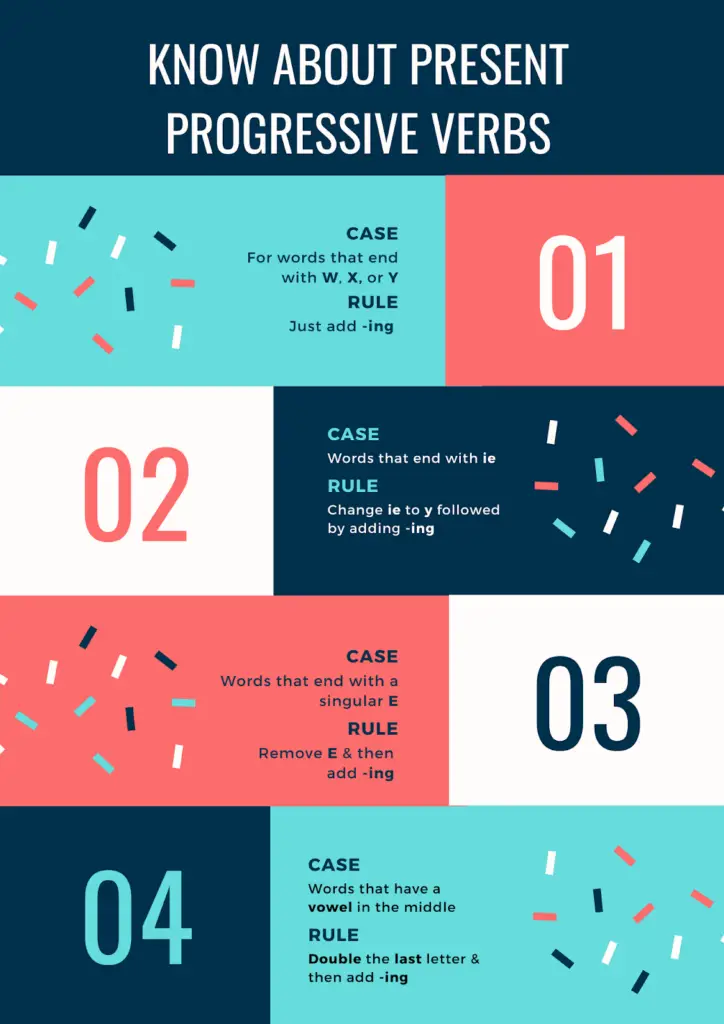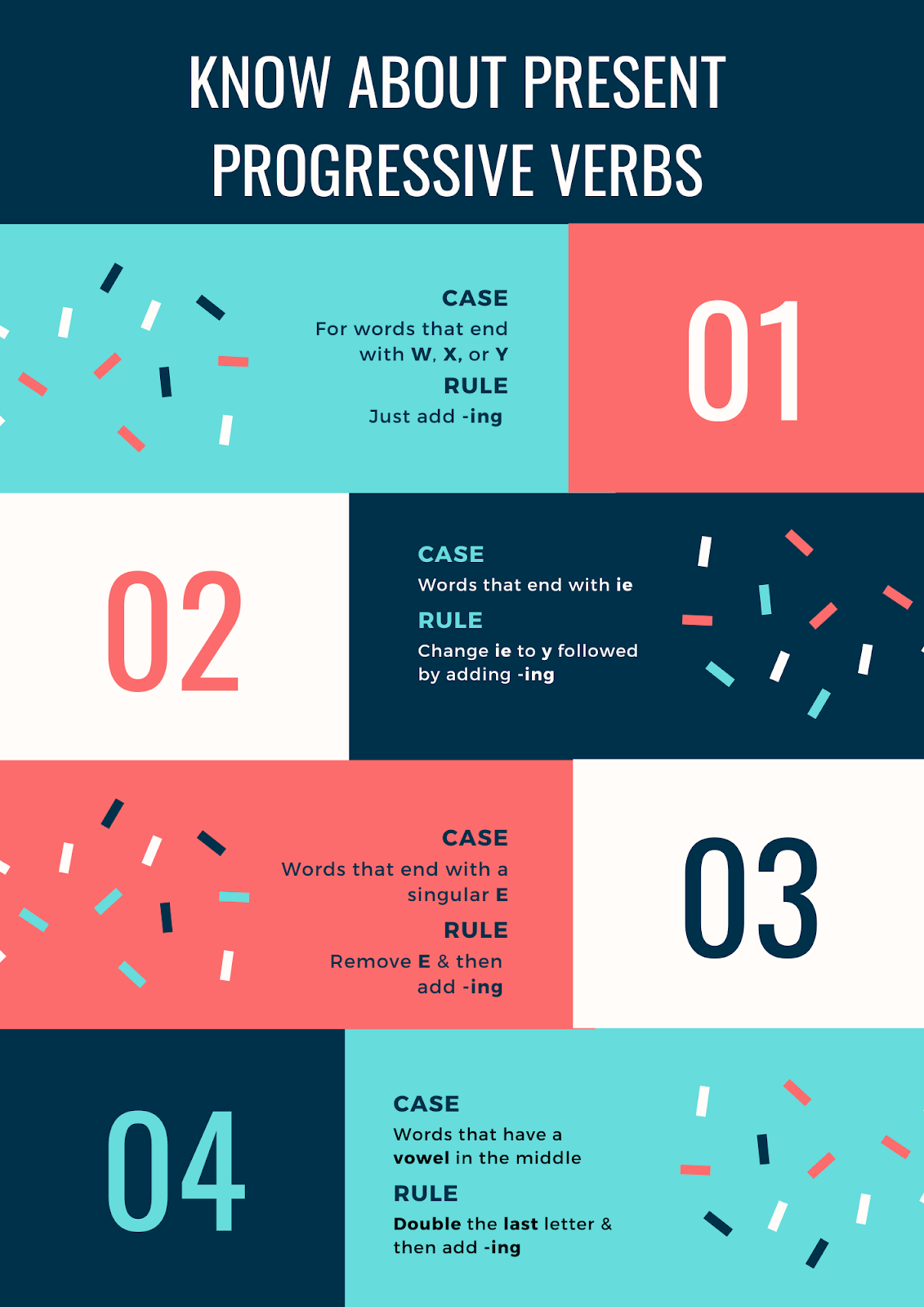Present progressive verbs describe an action that is taking place in real time, but has not been completed yet. In some cases, it can also be used to describe a definite event that will take place in the future.
Unlike simple present, present progressive/continuous is used to depict actions that are taking place in real time but are somewhat temporary. For example:
| Present Simple | Present Progressive |
| I read | I am reading |
| I work | I am working |
In the sentence above, ‘I am working’ states that a person is working currently. On the flipside, ‘I work’ tells us that the person works somewhere (A job is more permanent and cannot be changed every other day).
Keep on reading to know more about the present progressive verb -ing here.
Present Simple vs Present Progressive
As the name suggests, present progressive is used for an ongoing action. However, it is often confused with the simple present form. To avoid this, remember that the simple form of present tense is used whenever the action is permanent. We use progressive verb -ing for things that can change or are temporary.
| Permanent | Temporary |
| I live in New York. | Ash is living with his aunt. |
| We go to work together. | We are going to the party together. |
| I speak louder than she does. | I am speaking right now. |
Here are a few cases where these forms are used:
Simple Present
Simple present is used in the following situations:
For facts
- Tortoises live for 100 years.
- The Eiffel Tower is 330 meters tall.
- This train takes 8 hours to reach its destination.
For things that are true in the present time
- He is my husband.
- We read daily.
- England is the best cricket team at the moment.
For regular actions
- We play football every weekend.
- The train for Southampton leaves every hour.
- I ate breakfast at the table.
For habits
- I take piano classes every week.
- He only drinks coffee
- We always celebrate her birthday there.
Present Progressive

We use present continuous/ progressive verb -ing in these cases:
When an action is taking place in current time
- Ron is ironing his clothes right now.
- He is playing in the courtyard.
- We are waiting for her to join us.
When something is happening at this moment but hasn’t necessarily finished yet
- It is raining right now.
- My brother is sleeping downstairs.
- The soreness is increasing quite fast.
When talking about a future event which is near
- She is studying a lot for her exam.
- We are planning a trip to Brazil.
- I’ll be finishing this chapter by Friday.
Note: Certain verbs are not used in progressive tense. These include:
- Belong
- Seem
- Smell
- Understand
- Cost
- Hate
- Have (possession)
- Hear
- Need
- Own
- Remember
- Want
- Know
- Like
- Love
Aside from normal sentences, present progressive verbs when used in questions, can alter their meaning completely. For example: ‘What do you do’ is a question based on the present simple and refers to what a person does in general (occupation). ‘What are you doing’ is used when we want to ask what someone is doing in that particular moment.
Another way to distinguish between present progressive and present simple is to see the expressions that are tagged along. With simple present, words like always, often, sometimes, once a week, in the afternoon, etc. are used. Common expressions with present progressive tense are right now, at the moment, now, etc.
Changing a Sentence Into Present Progressive
Here is how we use present progressive tense:
Subject + am/is/are + verb-ing (present participle)
| Subject | Verb ‘to be’ | Present Participle |
| I | am | {verb}+ ing |
| You | are | |
| He/She/It | is | |
| We | are | |
| You | are |
Examples:
- I am going: Here ‘going’ is the present participle form and we are adding -ing to the verb ‘go’.
- You are talking: Here ‘talking’ is the present participle form and we are adding -ing to the verb ‘talk’.
Present participle is essentially the addition of a verb and ‘ing’.
Did you know? The German language does not have a present progressive tense like English.
Negative Version
If you need to use the present progressive form in a negative sentence, apply this rule:
Subject + is/am/are + not + present participle
Example:
- Chris is not looking at the correct page.
- Me and Jane are not going out tonight.
Question Version
This is the rule that applies when you need to ask a question:
Is/am/are + subject + present participle
Example:
- Is Christine going with you guys?
- Are Steve and Bill working right now?
Spelling Rules
Here are some spelling rules to keep in mind when forming present participles:
| Case | Rule | Example | Present participle |
| Words that end with w, x or y | Just add -ing | Snow, mix, cry, grow, | Snowing, mixing, crying, growing |
| Words that end with ie | Change ie to y followed by adding -ing | Lie, die, tie | Lying, dying, tying |
| Words that end with a singular e | Remove e and then add -ing | Make, dance, ride, save | Making, dancing, riding, saving |
| Words that have a vowel in the middle | Double the last letter and then add -ing | Shop, begin, get, swim | Shopping, beginning, getting, swimming |
Practice Exercises
In the sentences given below, pick the one which is written in the present progressive form:
- I am going now, you can come later if you want.
- You guys go ahead, I will catch up later.
Answer: Sentence A is written in the progressive form since the participle of go+ing has been used along with ‘am’.
- I hope while they are cooking the food, someone is bringing the dessert.
- When will you go to the supermarket?
Answer: Sentence A is written in the progressive form since the action is taking place in real time and participles -ing are used.
- Keep going until you reach the third left turn.
- It was so cold out there, my cat couldn’t stop meowing.
Answer: Both A & B are in their progressive form.
Related Articles
- How Are Most Adjectives Changed Into Adverbs? Explained Here
- Reflexive Pronouns – What Is A Reflexive Pronoun With Examples English
- Possessive Noun – What Are Possessive Form Of Nouns In English
Inquiries
If you have any questions or suggestions about the present progressive verbs -ing, please free to leave a comment below.


